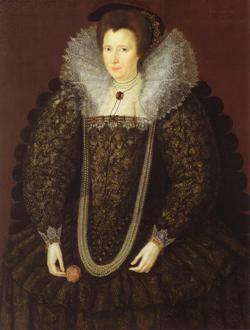Elizabeth Finch, 1st Countess of Winchilsea facts for kids
Quick facts for kids
|
|
|---|---|

Portrait of Finch, by Marcus Gheeraerts the Younger, c. 1600, formerly among the Lenthall pictures.
|
|
| Born | Elizabeth Heneage 9 July 1556 England |
| Died | 23 March 1634 (aged 77) England |
| Title | Countess of Winchilsea |
| Nationality | English |
| Spouse(s) | |
| Issue |
|
| Parents |
|
|
|
|
Elizabeth Finch, born Elizabeth Heneage, was an important English noblewoman. She lived from 1556 to 1634 and became the 1st Countess of Winchilsea. Her life story shows how some women gained power and titles in England long ago.
Contents
Elizabeth's Early Life
Elizabeth Heneage was born on July 9, 1556. Her father was Sir Thomas Heneage. He had important jobs for Queen Elizabeth I. He helped manage royal lands and was a top official in the Queen's household. Her mother was Anne Poyntz.
In 1593, Elizabeth's mother passed away. The next year, in 1594, her father married again. He married Mary Browne, who was the Countess of Southampton.
Her Family and Marriage
When Elizabeth was sixteen years old, she married Moyle Finch. This happened on November 14, 1572. Moyle Finch was born around 1550. He was the oldest son of Sir Thomas Finch.
Elizabeth and Moyle had several children together:
- Theophilius Finch (1573–1619), who later became the 2nd Baronet.
- Lady Anne Finch (1574–1638), who married Sir William Twysden.
- Heneage Finch (born 1576), who sadly died when he was young.
- Hon. Thomas Finch (1578–1639), who later became the 2nd Earl of Winchilsea. He married Cicely Wentworth.
- Hon. Sir Heneage Finch (1580–1631), who became the Speaker of the House of Commons.
- Hon. Francis Finch (born around 1585), who was a lawyer.
- Lady Catherine Finch, who married Sir John Wentworth.
Moyle Finch's Career
Soon after they married, Elizabeth's husband, Moyle, became a politician. He served as a Member of Parliament. This meant he was elected to represent different areas in the English government. He represented Weymouth, Kent, and Winchelsea at different times.
Moyle also held the role of High Sheriff of Kent in 1596 and 1605. This was an important local government job. In 1584, he was knighted, which meant he received the title "Sir." Later, in 1611, he was given the title of a baronet.
Elizabeth's Titles
Sir Moyle Finch passed away in 1614. After his death, Elizabeth and her sons worked hard to raise their family's standing. About nine years later, King James I gave Elizabeth a new title. She became Viscountess Maidstone. This title would pass down to her male heirs.
Then, in 1628, King Charles I gave her an even higher title. She became the Countess of Winchilsea. When Elizabeth died in 1634, her titles went to her oldest living son, Sir Thomas. He had already inherited his older brother's baronetcy in 1619.
A Special Monument
Elizabeth and Sir Moyle are shown resting in a special monument. This monument was created by a sculptor named Nicolas Stone around 1630. It was made after Sir Moyle's death, while Elizabeth was still alive.
Today, you can see this monument at the Victoria and Albert Museum in London. It was originally in a church called St Mary's in Eastwell, Kent. That church became a ruin in the 1950s.
Her Grandchildren
Through her son Heneage, Elizabeth had many grandchildren. She had seven grandsons and four granddaughters. One of her grandsons was Heneage Finch, who became the 1st Earl of Nottingham.
One of her granddaughters was Anne Conway. She was a very smart woman and a philosopher. She was known for her ideas and even influenced another famous thinker named Gottfried Leibniz.

